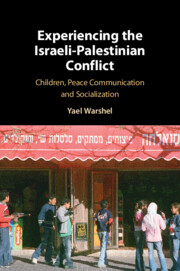Book contents
- Experiencing the Israeli-Palestinian Conflict
- Experiencing the Israeli-Palestinian Conflict
- Copyright page
- Dedication
- Contents
- Figures
- Tables
- Acknowledgments
- Note on the Text
- Abbreviations
- Introduction
- Part I The Encoding and Production of Israeli and Palestinian Sesame Street
- Part II Audience Reception of Israeli and Palestinian Sesame Street
- Part III Situating the Reception of Israeli and Palestinian Sesame Street in Mundane, Intractable Conflict Zone Practices
- Part IV Conclusions and Recommendations to Improve Peace Communication Research, (Evidence-Based) Practice and Conflict Intractability Interpretation
- Book part
- References
- Index
- Plate Section (PDF Only)
Introduction
Peace Communication and Why Study Israeli and Palestinian Sesame Street’s Media Intervention Model?
Published online by Cambridge University Press: 08 July 2021
- Experiencing the Israeli-Palestinian Conflict
- Experiencing the Israeli-Palestinian Conflict
- Copyright page
- Dedication
- Contents
- Figures
- Tables
- Acknowledgments
- Note on the Text
- Abbreviations
- Introduction
- Part I The Encoding and Production of Israeli and Palestinian Sesame Street
- Part II Audience Reception of Israeli and Palestinian Sesame Street
- Part III Situating the Reception of Israeli and Palestinian Sesame Street in Mundane, Intractable Conflict Zone Practices
- Part IV Conclusions and Recommendations to Improve Peace Communication Research, (Evidence-Based) Practice and Conflict Intractability Interpretation
- Book part
- References
- Index
- Plate Section (PDF Only)
Summary
Explores the emerging subdiscipline of Peace Communication (PeaceComm), beginning with a discussion about the history of the practice, and the author’s ongoing quest to introduce a subdiscipline, dedicated to assessing and evaluating the critical efficacy of the practice. A methodological template for comparative global assessment and evaluation is offered, stressing the need to prioritize political conflict data and conflict zones-based context analyses, given that political conflict is caused by collective grievances related to “group”-level disadvantages and perceived disadvantages, not individual prejudice. The template is operationalized through the assessment of Sesame Street interventions into the Israeli Palestinian ethnopolitical nationalist conflict, drawn from field work in 2001, 2004-2006, and 2011. Best practices and other interdisciplinary contributions for practitioners are recommended, to understand conflict intractability where socialization, culture, and inter-“group” (mediated and interpersonal) communication intersect in glocalized conflict zone contexts, and in the Israeli-Palestinian conflict, specifically. The interventions targeted children, who comprise the majority within conflict zones. The model used, mediated contact effects, is one of seven models and six subtypes of PeaceComm practiced historically worldwide the author has previously categorized, and is one of those most in need of PeaceComm scholarship, with potential to succeed but scarce evidence collected about its efficacy.
Keywords
- Type
- Chapter
- Information
- Experiencing the Israeli-Palestinian ConflictChildren, Peace Communication and Socialization, pp. 1 - 62Publisher: Cambridge University PressPrint publication year: 2021

